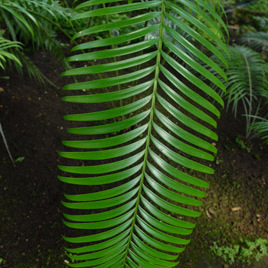Stem erect, to 20 m tall, to 50 cm diam. Leaves to 100 in the crown, 200-300 cm long; petiole 30-60 cm long. Pinnae 160-200, spreading, 20-40 cm long, 15-30 mm wide, with 15-30 parallel veins, hypostomatic. Male cones cylindrical, 25-40 cm long, 8-14 cm diam.; sporophylls cuneate, to 30 mm long, 25 mm wide. Female cones ovoid, 40-60 cm long, 20-30 cm diam.; sporophylls 5-8 cm long, apically 3.5-6.5 cm wide and 1.5-4 cm high. Seeds 40-70 mm long, 30-45 mm wide, red.


